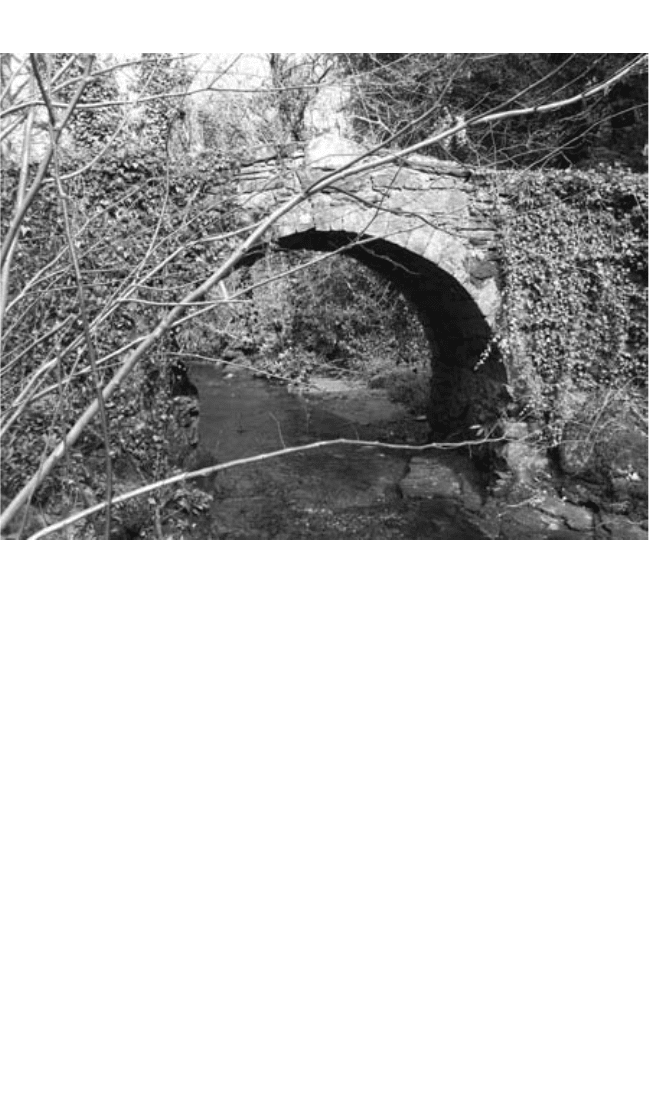Foyster E., Whatley C.A. A History of Everyday Life in Scotland, 1600-1800
Подождите немного. Документ загружается.


Chapter 10
Movement, Transport and Travel
Alastair Durie
Good roads, canals and navigable rivers . . . are the greatest of all improvements.
1
Adam Smith, The Wealth of Nations (1776)
INTRODUCTION
Writers on economic matters such as Smith were in no doubt as to the signifi -
cance of better transport to the development of any economy, including that
of Scotland. His contemporary as a political economist, Sir James Steuart,
converted analysis into argument. Author of a pamphlet in 1769 which advo-
cated better roads in Lanarkshire, he was one of many voices who called for
the further improvement of the roads, although welcoming the change that had
taken place within recent times. ‘A hundred years ago, there was not one cart
with iron shod wheels in any country parish. All carriages were on the back of
horses.’
2
A strong supporter of the Forth and Clyde canal, he was concerned
about what he called the dismal situation of the county roads, which meant
that during the winter, when the roads were ‘terrible until they join the turn-
pike road’, every access to Glasgow was quite cut off.
3
Better surfaces meant
that all-year-round carting could be introduced, which would cut costs and
enable grain to be moved to markets much more cheaply, and would benefi t
all. That would be one clear gain – there would be others – for everyday life.
The relationship, of course, between better transport and economic
growth is a complex one; sometimes change in transport leads to develop-
ment, sometimes it follows it, or the two run in tandem. And there was
always the vexed question, that Steuart addresses, of who was to fi nance
change, given that the state had little in the way of resources, which thrust
the onus on to local landowning and mercantile interests. For whatever
cause, whether poor administration, limited techniques or lack of fi nance,
it is generally agreed that pre-Improvement transport was poor: as Hamilton
says, the state of the roads was ‘deplorable’.
4
Traffi c was light in the coun-
tryside, except perhaps nearer the larger burghs, with little moving in the
winter or at night, though crop failure could result in a fl ow of beggars and
the destitute in search of subsistence. The run of bad harvests in the 1690s,
and resulting large-scale starvation forced tens of thousands – perhaps even
more – of the poor on the move to fi nd relief.
5
And some on this desperate
FOYSTER PAGINATION (M1994).indd 252FOYSTER PAGINATION (M1994).indd 252 29/1/10 11:14:0529/1/10 11:14:05

Movement, Transport and Travel 253
trek perished on the way: the parish of Montrose, to name but one of many,
between November 1697 and May 1698 had to organise four burials for
‘people who had died on the hills’.
But these times when the roads were choked with misery were abnormal,
and thankfully becoming more and more infrequent. In better seasons there
would be some of the gentry, their families and servants, other riders on busi-
ness, occasional peddlers and tinkers, even a funeral party, complete with ale,
spirits and shortbread on the road, but mostly life was slow and undisturbed
by movement to or through the parishes.
6
Poor transport was a symptom of
and confi rmed the backwardness of the economy. Many communities were
trapped at subsistence level, and while people would move, or even emigrate
– which has given Scotland the reputation of a mobile society – these were
mostly one-off movements forced by famine or war, or drawn by opportunity
rather than the lower level, less remarkable daily or weekly trips of the matur-
ing economy to fair, or market or dealer. It has been suggested that emigration
implies high levels of internal mobility, but whether that correlates with move-
ment on a daily or regular basis remains open.
7
Also, what movement there
was, often tended to be, as far as the lower orders were concerned, dictated
by others: carting or other duties; a servant or nurse following their master or
mistress in their travels. Many men in the countryside may have spent more
time working on the roads – every man aged between fi fteen and sixty was
supposed by law to do three days work in the summer and another three in
the autumn – than they ever did travelling on them. That such (unpaid) work
was grudgingly given, and ineffi ciently performed, can have come as no sur-
prise.
8
They could choose to pay a fee (‘commutation’) for the parish to hire a
substitute, but 3d. a day was a heavy drain on slight pockets, and inadequate
help as far as the road authorities were concerned as they had to pay three
times that for a day labourer. And the care of the roads, fi lling in potholes,
surfacing and other work was labour intensive. Dr James Anderson may well
have voiced the common mood well when he observed in 1794 that ‘the roads
are all made by the labour of the poor . . . many of whom have neither horses
nor carriages ever to travel on those roads . . . [b]ut the rich in consequence
of their labour are enabled to loll in their carriages at their ease’ – while these
same vehicles cut up the roads which the poor were forced to work to main-
tain.
9
Repairing the roads took a lot of labour, and building new roads even
more: the army had powers of direction and control over its working parties
which the civilian administrations must have envied. To muster 500 to 1,000
men for months of work, as Wade and Cauldfi eld did on the military roads
was an undertaking mostly beyond parish or county competence.
10
SOME PRELIMINARY OBSERVATIONS
There is, however, an assumption to challenge, that everyday life was penal-
ised by bad transport. There is no question but that all island and many
FOYSTER PAGINATION (M1994).indd 253FOYSTER PAGINATION (M1994).indd 253 29/1/10 11:14:0529/1/10 11:14:05

254 Alastair Durie
coastal communities had to face the reality of periods of isolation, sometimes
protracted, because of sea and storm, a situation not really addressed until
the coming of the steamships in the nineteenth century. But a bold question
is to ask what difference did it make to the mainland communities of the
cot-, kirk- or fermtoun? The miller was, perhaps, in a rather different posi-
tion; he needed to be able to move grain in and meal out. But people could,
and did walk, and everywhere. Age and physical condition, and if there was
anything to be carried, clearly were limiting factors, but those who wanted
to could cover a lot of ground. The thirty-year-old Coleridge, by no means a
person in peak physical condition, on his walking tour in Highland Scotland
averaged thirty to thirty-fi ve miles a day for eight days.
11
Religion would be
as powerful a motivation, perhaps more so for some, than pleasure or work
to travel. Daniel Defoe in the early 1720s remarked on a fi eld meeting or
conventicle being held in Dumfriesshire. An old Cameronian preacher, John
Hepburn, preached for seven hours (with a short break in the middle) to a
huge gathering of 7,000 people. To Defoe, the commitment of these people
was remarkable, as many of them had to come fi fteen or sixteen miles to hear
Hepburn, and ‘had all the way to go home again on foot’.
12
There would, it
can be agreed, have been severe disadvantages to a community of isolation:
among other things there could be local shortages of food which converted
into famine, or of imported raw materials which could bring rural outwork
to a stop. But there were also advantages of isolation for some, which were
to appear in a modernising economy when the ineffi cient rural producer or
worker was no longer protected by the cost of transport. Improvement was
a two-edged sword: factory-made products, for example, mill-spun yarn or
cloth, were to undercut rural production and hand spinning once the protec-
tion of high transport costs was removed.
Scotland was not a society without movement, but most movements
were only short in distance, collecting water and fuel, to the fi elds, infi eld or
‘out’, pasture or commons or to the shielings. In some areas there was the
slog of cutting and collecting peats, perhaps from a moss at some distance.
13
Peddlers, packsmen, chapmen, letter carriers, collectors of rags, vagrants,
disabled seamen and sailors made their way through the countryside, as did
the cattle dealers, drovers (and their dogs).
14
In the early summer there might
be a few Highland girls on their way to seek work on the Lowland harvest, a
trickle that was to become a stream in the later eighteenth century as Scottish
agriculture modernised.
15
Migrants from the countryside, usually young and
single, did fi nd their way to the towns for domestic service or apprentice-
ship. There would on occasion be emigrants on the road to the ports, pushed
out by privation or improvement, or drawn on by promise of better things
abroad. At times, there could be a substantial group on their way to an occa-
sional or annual visit to a healing well or spring, a practice long rooted in
country culture.
16
Despite Presbyterian disapproval, the folk still went to the
familiar places, perhaps not at a long distance but a day’s walk. ‘Every parish
FOYSTER PAGINATION (M1994).indd 254FOYSTER PAGINATION (M1994).indd 254 29/1/10 11:14:0529/1/10 11:14:05

Movement, Transport and Travel 255
has still its sainted well, which is regarded by the vulgar with a degree of
veneration, not very distant from that which in Papist and Hindoos we pity
as degrading,’ harrumphed the famous medical writer of the late eighteenth
century, Dr William Buchan.
17
Whether everyday life was really constricted is, therefore, one question.
There would have been potential gains if there had been better transport,
and indirect losses because there was not, but the system was in equilibrium
at a low level. There was a catch 22 situation: poverty kept transport poor,
but equally poor communications confi rmed the poverty. It is arguable that
the poorness of the system in part refl ected lack of demand for anything
better as well as a lack of means. And when improvement came, who ben-
efi ted? Longer distance trade in weighty commodities was a clear gainer, and
cheaper fuel and grain helped the urban communities, but here and even
more so in the countryside, did this not really benefi t only the elite of the
landowning and the merchant class? Did the rural poor fi nd their lives much
altered? In the later eighteenth century we shall see the arrival of travellers
and tourists in increasing numbers, travelling for leisure and pleasure, and
their increasing presence around Scotland. To what extent, however, did the
population of Scotland share in this other than those who were in the landed
and moneyed elite: did the other sections of society share in these new forms
of travel? These are issues to be addressed below.
A key problem which dogs discussion of this topic is that we have little, if
any, hard evidence as to the scale, distances and frequency of internal move-
ment. There are receipts from takings at the toll bridges and the turnpikes,
and some customs evidence as to the number of cattle crossing the border.
Upper class and business travellers have left some record of their travels, and
there are some odd statistics. Creech, for example, states that the number of
four-wheeled chaises in Edinburgh rose from 396 in 1763 to 1,427 in 1790, a
three-fold increase. He adds that in the latter year there were more than 6,450
wains (that is, heavy wagons) and carts, with ‘stage coaches, fl ies and dili-
gences available to every considerable town in Scotland’.
18
But these wheeled
conveyances were for the better-off, and the carts for goods. Much, in fact,
virtually all, of the movement of the ordinary people has left no trace, espe-
cially humdrum and mundane, the daily round, the weekly trip to market or
fair, to church on Sunday (virtually the only traffi c on the Sabbath) and even
the occasional outing to a well or spring. We know something about once-
in-a-life time movement, emigration or, as Houston and Whyte have shown
from study of apprenticeship and marriage records, migration pre-1800:
there was appreciable movement to the Scottish cities of young men and
women.
19
In the nineteenth century and perhaps earlier this was to generate
a reverse fl ow: the holiday visit to friends and relations in the countryside.
It can be asked whether this was a new development. Perhaps it was, aided
by better transport, more leisure time and disposable income. Or equally it
may have been a traditional pattern. But it, like so many forms of movement,
FOYSTER PAGINATION (M1994).indd 255FOYSTER PAGINATION (M1994).indd 255 29/1/10 11:14:0529/1/10 11:14:05

256 Alastair Durie
cannot be tracked. It easier to talk about how and why people may have
travelled, what the problems were and the issues for those who moved and
those whom they moved among, than to assess the scale or understand the
experience. Also largely hidden from history is the experience of those who
travelled as wives or servants or children. In short, much of the mundane
and the everyday is off the screen.
THE OLD ORDER IN TRANSPORT
If there is one issue on which late eighteenth century writers agreed, (whether
in the First or Old Statistical Accounts (OSA) or the General Surveys of
Agriculture, and current academic assessment has followed) it is as to
how diffi cult it was to make your way round Scotland before things were
improved. Sea travel faced the diffi culties of wind, wave and tide, and naviga-
tion without charts or lighthouses, with privateering an additional problem
during periods of war. Ferry crossings were a lottery with the humour and
condition of the ferrymen always uncertain. A petition in 1739 about the fer-
ryman at Cambusbarron complained that he was ‘rude, unnatural and always
drunk and out of the way’.
20
Fords were dangerous especially when rivers
were in spate, and bridges were few and far between. To cross some bridges
required the payment of a much grudged toll. The roads were ill kept, not
signposted, with goods moved either by packhorse or on a sledge. There
were some carts, but any kind of wheeled vehicle was quite unknown in
many parishes.
21
‘A hundred years ago there was not one cart with iron-shod
wheels in any country parish. All carriages were on the back of horses’ was
the view of Sir James Steuart.
22
Chris Smout quotes Grant of Monymusk’s
retrospective view of the dismal state of transport about 1716: ‘no repair of
roads, all bad, and very few wheel carriages; no coach, carriage or chaise and
few carts benorth Tay’.
23
Traffi c was confi ned to the day and to the better
weather: ‘few travelled in winter if they could help it’.
24
Retreat forced the
Jacobite army to leave Aberdeen in ferocious winter weather, but few if any
ordinary people could have managed thirty-nine miles in two days under
such conditions on what were merely tracks.
25
Travellers’ accounts stressed
with feeling how big the contrast was between the old and the new. In the
summer of 1758, Sir John Burrell followed the new road that the military
were making between Inveraray and Tyndrum, but when it came to an end
after four miles, he and his party found themselves on ‘the most horrid
paths than can be conceived’.
26
Adam Bald, a young Glasgow merchant, was
returning home to Glasgow from Stirling in November 1792 on the new road
being made by way of Cumbernauld. About a mile or so south of the village
he came on a part of the road which in his words was ‘not cut’, and had to
scramble through fi eld and heather for about three miles. Six months later it
was still not completed and was little more than a ‘quagmire’.
27
Yet the picture of the defi ciencies of the old system and its administration
FOYSTER PAGINATION (M1994).indd 256FOYSTER PAGINATION (M1994).indd 256 29/1/10 11:14:0529/1/10 11:14:05

Movement, Transport and Travel 257
by local justices of the peace may have been overdrawn. Things certainly got
better in the later eighteenth century, but they were not necessarily quite
as bad before then as is assumed. There is a story made popular by Henry
Graham (picked up by Christopher Smout) which has coloured our view of
how bad things were. This is an anecdote of the locals turning out to gape at a
wheeled cart in Cambuslang in 1723, a cart carrying a small load of coals from
East Kilbride: ‘crowds of people went out to see the wonderful machine: they
looked with surprise and returned with astonishment’. The original source
for this, is David Ure’s history of Rutherglen and East Kilbride.
28
It seems
to imply, and so it has been read, that it was the sight of wheels that was
the source of wonder. But an alternative reading which the text will equally
support is that the emphasis should be put on the fact that it was the fi rst
‘to be made in the parish’. In any case this was a recollection which was not
fi rst hand, but of something said to have happened some ‘70 years ago’ when
there was not a cart in the parish and very few sledges. Ure’s account of the
parish in the 1790s for Sir John Sinclair, used this anecdote from the past to
point to the remarkable improvement in affairs. Two-wheeled horse-drawn
wagons were in common use, with a carry of some one-and-a-half tons of
coal each, capable of taking several loads a day to Glasgow. This story, of
the amazed crowd, is wheeled out to confi rm how great the recent advance
had been and to corroborate the widely held view that before the Industrial
Revolution, the roads system was primitive, and as a result wheeled trans-
port a rarity. But perhaps it should be taken with a pinch of salt.
John Harrison’s important work on the roads in and around Stirling,
which needs testing for other areas, serves as an important corrective. He
shows that from the early 1660s to the mid-1690s, the system had built
several new bridges and repaired others, and that ‘the main roads, and
perhaps some of the lesser ones now had better surfaces’.
29
The use of statute
labour could be made to work, not that common folk necessarily enjoyed
their days’ labour, nor was it always put to good use. To the maintenance
of the roads was added the making of bridges, often by public subscription,
over rivers such as the Clyde and the Tay. There was the Bow Bridge over the
Lossie at Elgin, which bears the inscription ‘foundit 1630, fi nishit 1635’,
30
that
at Montrose over the Esk, prompted by the dangers of the ford,
31
and the
one over the Don at Inverurie. There were gaps, as at Fochabers, and drovers
did lose beasts trying to swim them across fi rths and rivers.
32
The crossings
of the estuarial Forth or the Tay were a continuing hazard: there the ferries
remained to the dismay of many travellers. But people could and did travel.
The recently published diary for 1689–90 of John Allan gives pause for refl ec-
tion. Allan was a thirty-year-old itinerant preacher, and authentic voice, who
was making his way round the north-east of Scotland and up to the Black
Isle. There were, indeed, diffi culties for him. In October 1689 he got lost
among the mosses on the moor of Balnagowan, near Tain. The locals spoke
only Gaelic (the language barrier in the north may have been echoed for the
FOYSTER PAGINATION (M1994).indd 257FOYSTER PAGINATION (M1994).indd 257 29/1/10 11:14:0529/1/10 11:14:05

258 Alastair Durie
visitor elsewhere by the challenge of dialect) and he could not follow their
instructions. This caused him to wander to and fro at length until he found a
boy coming up the hill who had ‘Scots and knew the way – I was much com-
forted’. But the surprising thing is how often he seems to have travelled even
in quite remote areas without too much fuss here and there. Although in
May 1690 he was held up in Aberdeen by a shortage of horses to hire, mostly
he could fi nd a supply, even if there was an element of accident (or what he
would have called providence) involved. His entry for 5
December when he
was on the Black Isle records that he ‘met with some who had empty horses,
from whom I got one betwixt the ferries and sent back that which I had. I had
two miles to go on foot to Newmore after crossing the ferry of Inverbrackie,
for I could not get a horse for hire. But got a boy who carried my boots &
clock [cloak?] the most of the way.’
33
A CHANGED WORLD OF TRANSPORT
The supply of horses for hire was in part related to the growth of the postal
system, which meant that postmasters had a stock of horses available for
Figure 10.1 Leckie Bridge, 1673. One of a number of small, but sturdy and serviceable
bridges built in Stirlingshire during the 1670s, this at Leckie near Gargunnock from 1673
carries the inscription in Latin ‘built out of benevolence for safety’s sake’. Source: John G.
Harrison.
FOYSTER PAGINATION (M1994).indd 258FOYSTER PAGINATION (M1994).indd 258 29/1/10 11:14:0529/1/10 11:14:05

Movement, Transport and Travel 259
hire. There was also the rise of carting as a separate occupation, rather than
just a fi ll-in activity for farm workers: the incorporation of carters at Leith
could afford their own convening house by 1726.
34
Haldane’s study of the
postal system in Scotland shows that during the seventeenth century there
was an evolving network of posting offi ces.
35
The mail was carried from the
south by horse to Edinburgh with a distribution network onwards, by horse
on the main routes and on foot to the rural areas thereafter. As a rule, poor
people neither sent nor received letters; the lowest stratum was perhaps a
master manufacturer or a tenant farmer. But the arrival of the post carrier
on his weekly trudge must have been a source of interest and of news, some-
thing to lighten the day, and break up the routine. At Inveraray during the
period from 27 April to 31 December 1734 over 2,450 letters – incoming
and outgoing – passed through the hands of the postmaster there, brought
by a weekly runner from Dumbarton.
36
Having been sorted, they were sent
onwards by a further network of runners. The letter carrier was sometimes
paid only when the letter was delivered, remunerated by the addressee not
the sender, a mechanism that ensured delivery.
Prior to 1715, except for the horse post to and from England, mail was
carried everywhere on foot. But this began to change; a new horse post was
inaugurated to Stirling from November 1715, to Glasgow in 1717 and a
faster network spread out. The three dispatches a week conveyed by relays
of horses from Edinburgh to Aberdeen had become fi ve from 1763. The
heaviest traffi c was on the road to and from Berwick: mail to London in the
early 1750s took eighty-fi ve hours while the return (‘inexplicably’) took 131
hours! As the weight of traffi c increased, thanks to newspapers, packets and
letters, the introduction of mail coaches was forced, fi rst on the Edinburgh
to London route in 1785 and then elsewhere. The improvement in the postal
service was but one facet of a developing economy, and one element in the
increase in traffi c on the roads which fed off better roads and into the need
for better surfaces. The foot traveller, and the drover, with his self-propelled
freight, was probably affected least (except insofar as harder road surfaces
hurt the hooves of his cattle). If there were goods to be taken to market –
cloth, shoes, peats – the local worker benefi ted, with the wheelbarrow an
increasingly common sight. The longer-distance traveller with money ben-
efi ted most from better roads and more regular services, as did the merchant
with bulky commodities to move and, indeed, from coastal shipping serv-
ices. Foodstuffs and fuel were moved with increasing ease and at lower cost,
and suppliers and buyers, but not the less effi cient producer, alike reaped
the benefi t.
There was, therefore, a substantial rise in traffi c, which the roads saw, and
the rural community (depending on location) would have seen both many
more people passing through their parishes and a more varied cast of travel-
lers. There would still have been the tinkers, vagrants and the poor on the
road in search of relief or work. Recruiting parties, ‘decked in all the glory of
FOYSTER PAGINATION (M1994).indd 259FOYSTER PAGINATION (M1994).indd 259 29/1/10 11:14:0529/1/10 11:14:05

260 Alastair Durie
war paint, preceded by fi fe and drum’ were a sight some sought and others
avoided.
37
There could have even be the occasional soul on their way to seek
treatment at a spa as was Margaret Stirling of Stirling, her passage to Moffat
in 1755 eased by fi ve shillings from Cowane’s hospital.
38
In the summer,
migrant harvest labour would have been on the move, their ranks swollen
by artisan workers from the villages and towns taking a change of work as a
break.
39
Boys, and some girls, from some of the rural burghs were hired out
for herding during the summer.
40
A quickening economy meant more goods
were sent to market by packhorse and by cart, with more raw materials in
transit. Development required supervision; there were agents, factors, sur-
veyors, yarn and cloth inspectors on the road not just for an occasional trip.
Patrick MacGillvrie, the Board of Trustees’ surveyor of bleaching, under-
took a fi fteen-week tour of fi nishing greens in eastern Scotland in 1763.
41
Signifi cantly, the Board’s top man in the fi eld was called the Riding Inspector
of Manufactures. There were more of the great and the good en route: more
law and administration meant that there were the retinues of the judges on
circuit; the landowners, their families and servants; delegates en route to the
Convention of Royal Burghs; and presbyters to the General Assembly. There
were also the members of parliament. The Union of 1707 created forty-six
members from Scottish constituencies elected to serve in parliament at
London, which usually met for fi ve or six months beginning in November
or December. It is interesting to ask how often did they attend, and if so
how did they (and the increasing numbers of lobbyists for the Convention
of Royal Burghs, for example) travel from Scotland?
By what means did
someone like Sir Alexander Cumming of Culter, MP for Aberdeenshire get
to London where he voted in the debate over the Repeal of the Conformity
and Schism Acts in January 1719?
42
Or Henry Cunningham of Bolquhan,
MP for Stirling Burghs, when he voted in June 1717? Or, indeed, whether
some who might have travelled south, and perhaps should have done so, did
not because of the inconvenience. We do know that after the terms of the
Union had been settled, the queen’s commissioner in Scotland, the duke of
Queensberry, and his entourage travelled in April 1707 to London in two
coaches, accompanied by servants on horseback.
43
But his was a required
trip, and others either less fi t or less motivated, might not have gone. It is
perhaps no accident that the road south from Edinburgh was improved after
the Union, to the benefi t of the dedicated and energetic politician. The fi rst
coach service to London began in 1734 with eighty stout horses stationed at
proper distances to allow the journey to be performed in nine days. Glasgow
to Edinburgh followed in 1749. Travel by coach became an accepted part of
life among the better off, uncomfortable as it must often have been: heavy
expense, jolting and long delays was one verdict. Things were rather more
relaxed in the north. It was not unknown for the Inverness coach to take a
scenic diversion of a few miles to oblige a lady or a tourist, or to take a stop
for an afternoon tumbler of whisky or glass of port.
44
Those who had their
FOYSTER PAGINATION (M1994).indd 260FOYSTER PAGINATION (M1994).indd 260 29/1/10 11:14:0529/1/10 11:14:05

Movement, Transport and Travel 261
own carriages had more fl exibility as to when and at what pace they travelled.
Sir John Sinclair, for example, in the 1780s, using his own carriage rather
than the public stage coach service, was able to come back from London
during the short Christmas recess. During the summer in Scotland he was
equally able to go up and down between Caithness where his estates were,
and Edinburgh where he had a range of offi cial interests.
45
CHANGE AND IMPROVEMENT: HOW WAS THIS ACHIEVED?
While the old order may have been less awful than has been painted, it
was nevertheless poor. One can accept as a broad-brush assessment Ann
Gordon’s view that transport improvement ‘really began in the eighteenth
century’ and that from the 1750s the scale and nature of change was remarka-
ble.
46
Most attention has been paid to road making; but it is worth noting that
coastal shipping services also improved. Voyages were not necessarily any
faster, but they were now scheduled on the main sea routes: Leith–London,
for example. Ferry crossings remained problematic; neither travellers nor
their horses took kindly to the service on even quiet water. And there were
all too frequent accidents. Eighteen people were drowned when the over-
crowded Moulin ferry across the Tay capsized on the evening of a Fair day
in February 1767; the local response was to build a bridge to do away with
the ferry crossing entirely.
47
The pace of change to the mainland roads varied
from area to area, but a sure sign of improvement was the arrival of wheeled
transport; the cart for goods and the carriage for people. Much attention has
been paid to the ‘new form’ of road, or innovation of the turnpike: the fi rst
Act, and each scheme required parliamentary sanction, was for Midlothian
in 1713. Progress was slow thereafter: by 1788 there were only eighteen
turnpike trusts in Scotland, none north of Perth. But the pace quickened:
according to Sinclair over 3,000 miles of turnpike road had been created by
1810, three-quarters of them in the previous twenty years. Contemporaries
were enthusiastic. The minister at Sanquhar, the Revd William Ranken,
described in 1793 how tolls bars had been erected on the road from Dumfries
to Ayr, an important route. Gradients had been smoothed out and a more
direct line taken in places, with the result that the road was much easier for
wheeled traffi c.
48
There was no doubt, he concluded, as to ‘the expediency
and utility of turnpike roads’. Yet they had their critics. Not all were as well
made, nor did income always match expectation, thanks to the country folk
evading the toll houses where they could, which had an effect on the level
of maintenance. Moreover not every new road was a toll road. Ranken also
drew attention, perhaps with his stipend in mind, to the twenty-two miles of
work on the great road between Dumfries and Ayr which the late duke of
Queensberry had had ‘cut’ at his own expense, at the cost of some £1,500.
And the construction or improvement of various cross roads was also cred-
ited to the duke. The drive to improve not just the longer distance routes,
FOYSTER PAGINATION (M1994).indd 261FOYSTER PAGINATION (M1994).indd 261 29/1/10 11:14:0529/1/10 11:14:05
